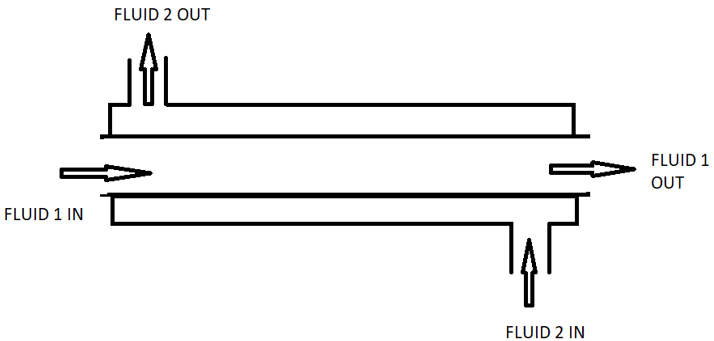This set of Thermal Engineering Multiple Choice Questions & Answers (MCQs) focuses on “Heat Exchangers”.
1. A periodic type heat exchanger is known as _____
a) Direct contact heat exchanger
b) Indirect contact heat exchanger
c) Recuperator
d) Regenerator
View Answer
Explanation: A periodic type heat exchanger is known as regenerator. Recuperator are heat exchanger in which two fluids are separated by a wall.
2. Surface heat exchangers are also known as _______
a) Direct contact heat exchanger
b) Indirect contact heat exchanger
c) Recuperator
d) Regenerator
View Answer
Explanation: Recuperator are heat exchanger in which two fluids are separated by a wall. Recuperator is also called surface heat exchangers. In direct flow heat exchanger two fluids exchange heat by coming in direct contact.
3. In which type of heat exchanger the same space is occupied by the hot and cold gases, between which heat is exchanged?
a) Recuperator
b) Regenerator
c) Direct contact heat exchanger
d) Indirect contact heat exchanger
View Answer
Explanation: A periodic type heat exchanger is known as regenerator. Regenerator heat exchanger in which the same space is occupied by the hot and cold gases, between which heat is exchanged. Recuperator are heat exchanger in which two fluids are separated by a wall.
4. Which of the following is not an application of regenerator?
a) Jet condenser
b) Steam power plant
c) Oxygen producer
d) Blast furnace
View Answer
Explanation: Regenerators find their applications in steam power plant, oxygen producer and blast furnace. The application of direct contact type heat exchanger are open feed water heaters, de-super heater and jet condensers.
5. What property of cold fluid remains constant in case of evaporator?
a) Volume
b) Temperature
c) Entropy
d) Enthalpy
View Answer
Explanation: In case of evaporator the temperature remains constant as pressure does not change. The temperature of hot fluid decreases.
6. LMTD in case of condenser will ________ for counter and parallel flow heat exchanger.
a) Remain same
b) Not be equal
c) Cannot be determined
d) Will not change with time
View Answer
Explanation: In case of condenser and evaporator ∆T1 and ∆T2 remains same in case of counter and parallel flow heat exchanger. Therefore LMTD in case of condenser will be same for counter and parallel flow heat exchangers.
7. How many categories heat exchanger can be classified based on nature of heat exchange process?
a) 1
b) 2
c) 3
d) 4
View Answer
Explanation: The classification of heat exchanger on the basis of nature of heat exchange:
- Direct contact
- Recuperator
- Regenerator
8. Which type of flow arrangement is this?

a) Parallel
b) Counter
c) Regenerator
d) Shell and tube
View Answer
Explanation: In this type of arrangement fluids enter and leaves from opposite side, also flow in opposite direction. Therefore in this arrangement type flow is counter flow.
9. Which type of flow arrangement is this?

a) Parallel
b) Counter
c) Regenerator
d) Shell and tube
View Answer
Explanation: In this type of arrangement fluids enter and leaves from same side, also flow in same direction. Therefore in this arrangement type flow is parallel flow.
10. In which of the following recuperator heat exchanger is not used?
a) Evaporator
b) Chemical factories
c) Automobile radiators
d) Condensers
View Answer
Explanation: Recuperator are heat exchanger in which two fluids are separated by a wall. Recuperator is not used in chemical factories. It is used in condenser, evaporator and automobile radiator.
11. Number of categories heat exchanger can be classified based on the direction of flow of fluids is ______
a) 1
b) 2
c) 3
d) 4
View Answer
Explanation: The classification of heat exchanger on the basis of the direction of flow of fluids are:
- Counter flow heat exchanger
- Parallel flow heat exchanger
- Cross flow heat exchangers
12. Number of categories heat exchanger can be classified based on the mechanical design of heat exchanger surface is ______
a) 1
b) 2
c) 3
d) 4
View Answer
Explanation: The classification of heat exchanger on the basis of the mechanical design of heat exchanger surface:
- Concentric tube
- Shell and tube
- Multiple shell
13. Number of categories heat exchanger can be classified based on the physical state of heat exchanging fluid is ____
a) 1
b) 2
c) 3
d) 4
View Answer
Explanation: The classification of heat exchanger on the basis of the physical state of heat exchanging fluid:
- Condenser
- Evaporator
14. In which of the following type of heat exchanger the heat exchange between the two fluids occur by their complete physical mixing?
a) Direct contact heat exchanger
b) Indirect contact heat exchanger
c) Recuperator
d) Regenerator
View Answer
Explanation: In direct contact type of heat exchanger the heat exchange between the two fluids occur by their complete physical mixing. Recuperator are heat exchanger in which two fluids are separated by a wall. Regenerator heat exchanger in which the same space is occupied by the hot and cold gases, between which heat is exchanged.
Sanfoundry Global Education & Learning Series – Thermal Engineering
To practice all areas of Thermal Engineering, here is complete set of 1000+ Multiple Choice Questions and Answers.
If you find a mistake in question / option / answer, kindly take a screenshot and email to [email protected]
- Check Mechanical Engineering Books
- Check Thermal Engineering Books
- Apply for Chemical Engineering Internship
- Practice Mechanical Engineering MCQs
- Practice Chemical Engineering MCQs
